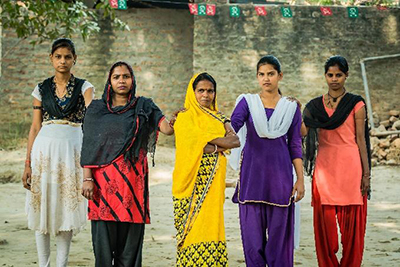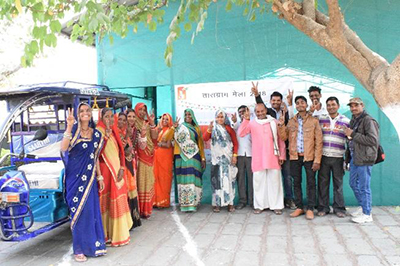|
Emerging peer to peer
networks,
enabling job creation
If you want to go fast, go alone. If you
want to go far, go with others. says an African proverb.
Peer
to peer networks are not a new concept and have been a fundamental part
of human society. Especially in terms of business, the market has always
been driven by peer networks that find synergies and profits through
relationships and generate livelihoods. India needs to generate 120
million new livelihoods in the 20212030 decade to ensure near full
employment for its 610 million labor force by 2030 . In light of the
current pandemic situation, the need for dignified jobs will further
increase as more than 41 lakh jobs were reported to be lost by the pandemic in 2020. The
policy landscape presumes that large enterprises can generate this gamut
of jobs and thus favours them. This resulted in a strong peer to peer
connection amongst large enterprises, formalised through institutions
like FICCI which facilitates amicable relations. But the concentration of efforts
at the large enterprise scale while commendable, misses the crux of
India's livelihood problems. Building micro-enterprises at the
grassroots, with efforts to build peer connections between them, as well
as theirs with stakeholders can build up local entrepreneurial
ecosystems, deepening local socio-economic well-being and solidarity,
especially in uncertain times such as that of the pandemic. From the
perspective of sustainable growth, it is really the micro-enterprises
that hold the promise to address India's uncertain future with respect
to generate dignified livelihoods. Micro-enterprises, which comprises of
99% of total enterprises in the MSME and employs 10.7 million
individuals , can therefore not only spark activity in local economies
but peer to peer connections between entrepreneurs at the local scale
can also spark solidarity in meeting local needs, providing support
services for new entrepreneurs, and leveraging upcoming opportunities in
new sectors such as e-commerce, organic farming, agro-processed and
allied services and so on. Such possibilities are crucial as employment
and enterprises of the most marginalised have been adversely affected by
the pandemic, and thus finding new ways to revive socio-economic
well-being is the need of the hour.
than 41 lakh jobs were reported to be lost by the pandemic in 2020. The
policy landscape presumes that large enterprises can generate this gamut
of jobs and thus favours them. This resulted in a strong peer to peer
connection amongst large enterprises, formalised through institutions
like FICCI which facilitates amicable relations. But the concentration of efforts
at the large enterprise scale while commendable, misses the crux of
India's livelihood problems. Building micro-enterprises at the
grassroots, with efforts to build peer connections between them, as well
as theirs with stakeholders can build up local entrepreneurial
ecosystems, deepening local socio-economic well-being and solidarity,
especially in uncertain times such as that of the pandemic. From the
perspective of sustainable growth, it is really the micro-enterprises
that hold the promise to address India's uncertain future with respect
to generate dignified livelihoods. Micro-enterprises, which comprises of
99% of total enterprises in the MSME and employs 10.7 million
individuals , can therefore not only spark activity in local economies
but peer to peer connections between entrepreneurs at the local scale
can also spark solidarity in meeting local needs, providing support
services for new entrepreneurs, and leveraging upcoming opportunities in
new sectors such as e-commerce, organic farming, agro-processed and
allied services and so on. Such possibilities are crucial as employment
and enterprises of the most marginalised have been adversely affected by
the pandemic, and thus finding new ways to revive socio-economic
well-being is the need of the hour.
In order to strengthen the local rural micro
entrepreneurs, re-building the peer to peer network can open alternate
and sustainable supply chains. Through peer to peer networks,
individuals are connected with underlying goals such as earning profit,
supporting fellow businessmen or networking, irrespective of any
sectoral differences. Peer to Peer networks allow autonomy
to all its stakeholders and also ample scope for non-linear (and often
unconventional) flows which promotes innovation as well as
resourcefulness.

Development Alternatives, across multiple of
its enterprise development programs, have built evidence around the
power of peer to peer networks at a micro and meso (district) level. One
of the approaches which have helped Development Alternatives in
strengthening the peer to peer network is the social innovation approach
in which deep listening exercises assisted by co-creation tools and
prototyping methodology is helping rural micro-entrepreneurs to leverage
existing local relations into peer to peer networks for business
sustainability and reach economies of scale. They are doing so in the
following ways:
-
a) Developing supply chains and
aggregation channels: Asha Devi, a vermicomposting entrepreneur in
Mirzapur best example of peer to peer network. She not only encourages
and motivates her peers to do something on their own but also give them
training on composting and helps them to set up an enterprise. Asha Devi
aggregates the bio compost from them and sells it to nearby nurseries.
This has enabled development of supply channels within the community.
This network now sustains 14 enterprises which includes vermicomposting,
nursery, cattle rearing and generates 35+ livelihoods. Asha Devi herself
has become a role model for her sister-in-law Mamta who has started her
own ice cream manufacturing business which directly employs 15+ youth.
-
b) Local support system and mentorship:
As mentioned, the main focus of peer 2 peers is learning and growing
together. Kajal Parihar in Bundelkhand is the first woman to run an
information kiosk. She observed the needs of her village and got the
idea to open an info kiosk. She visited nearby villages and collected
information on how to run an information kiosk from one of the existing
entrepreneurs, Sappu Pandey. Through her help 2 more women have also
started their info kiosks. This way peer to peer network enables
exchange of knowledge and learnings, sets up enterprises and also
creates a chain of impacts.
-
c) Digital outreach: As the
penetration of internet and mobile connectivity increases in the rural
areas, peer networks are also evolving fast through digital platforms/
networks and thus generating livelihoods. Platforms like WhatsApp
groups, Facebook pages etc. are being used for linking rural youth with
new age livelihoods. In line with this, the development of an innovative
technology, which uses raspberry pi technology to connect more than 53+
young women to digital livelihood opportunities like web designing,
content developer etc.
The above approach uses various social
innovation tools like Kaun Banega Market Leader which is a public level
competition aimed at gathering ideas on innovative marketing models. The
competition was aimed at seeking innovative marketing ideas from women
and youth to overcome barriers of market access for rural entrepreneurs
and unlock opportunities for expansion of their enterprises. Likewise,
the current form of peer to peer networks work within informal networks,
yet this informality is creating networks and connections which is
enabling livelihood creation and supporting each other for skills
enhancement. Thus creating a discourse that enables an entrepreneurial
ecosystem that works in harmony with livelihood generation.■
References
-
https://livelihoods-india.org/publications/all-page-soil-report.html
-
https://www.bloombergquint.com/economy-finance/41-lakh-youth-lose-jobs-in-india-due-to-covid-19-impact-ilo-adb-report
-
https://msme.gov.in/sites/default/files/MSME-ANNUAL-REPORT-ENGLISH%202020-21.pdf
Debasis Ray
dray@devalt.org
Roopali Gupta
rgupta@devalt.org
Back to Contents
|
 than 41 lakh jobs were reported to be lost by the pandemic in 2020. The
policy landscape presumes that large enterprises can generate this gamut
of jobs and thus favours them. This resulted in a strong peer to peer
connection amongst large enterprises, formalised through institutions
like FICCI which facilitates amicable relations. But the concentration of efforts
at the large enterprise scale while commendable, misses the crux of
India's livelihood problems. Building micro-enterprises at the
grassroots, with efforts to build peer connections between them, as well
as theirs with stakeholders can build up local entrepreneurial
ecosystems, deepening local socio-economic well-being and solidarity,
especially in uncertain times such as that of the pandemic. From the
perspective of sustainable growth, it is really the micro-enterprises
that hold the promise to address India's uncertain future with respect
to generate dignified livelihoods. Micro-enterprises, which comprises of
99% of total enterprises in the MSME and employs 10.7 million
individuals , can therefore not only spark activity in local economies
but peer to peer connections between entrepreneurs at the local scale
can also spark solidarity in meeting local needs, providing support
services for new entrepreneurs, and leveraging upcoming opportunities in
new sectors such as e-commerce, organic farming, agro-processed and
allied services and so on. Such possibilities are crucial as employment
and enterprises of the most marginalised have been adversely affected by
the pandemic, and thus finding new ways to revive socio-economic
well-being is the need of the hour.
than 41 lakh jobs were reported to be lost by the pandemic in 2020. The
policy landscape presumes that large enterprises can generate this gamut
of jobs and thus favours them. This resulted in a strong peer to peer
connection amongst large enterprises, formalised through institutions
like FICCI which facilitates amicable relations. But the concentration of efforts
at the large enterprise scale while commendable, misses the crux of
India's livelihood problems. Building micro-enterprises at the
grassroots, with efforts to build peer connections between them, as well
as theirs with stakeholders can build up local entrepreneurial
ecosystems, deepening local socio-economic well-being and solidarity,
especially in uncertain times such as that of the pandemic. From the
perspective of sustainable growth, it is really the micro-enterprises
that hold the promise to address India's uncertain future with respect
to generate dignified livelihoods. Micro-enterprises, which comprises of
99% of total enterprises in the MSME and employs 10.7 million
individuals , can therefore not only spark activity in local economies
but peer to peer connections between entrepreneurs at the local scale
can also spark solidarity in meeting local needs, providing support
services for new entrepreneurs, and leveraging upcoming opportunities in
new sectors such as e-commerce, organic farming, agro-processed and
allied services and so on. Such possibilities are crucial as employment
and enterprises of the most marginalised have been adversely affected by
the pandemic, and thus finding new ways to revive socio-economic
well-being is the need of the hour.
